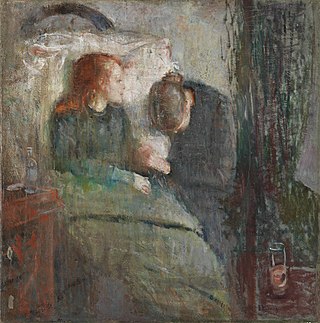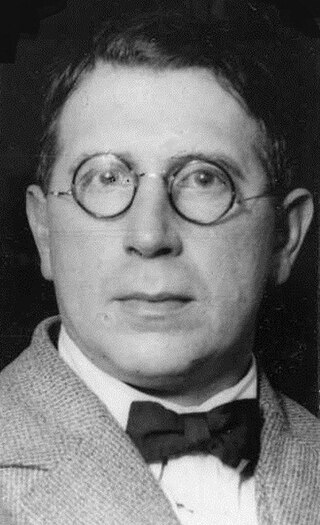| Morning Yawn | |
|---|---|
 | |
| Artist | Edvard Munch |
| Year | 1913 |
| Medium | Oil on canvas |
| Dimensions | 108 cm× 98 cm(43 in× 39 in) |
| Location | KODE – the Artmuseums of Bergen, Bergen, Norway |
Morning Yawn is a 1913 painting by the Norwegian artist Edvard Munch. [1] [2]
| Morning Yawn | |
|---|---|
 | |
| Artist | Edvard Munch |
| Year | 1913 |
| Medium | Oil on canvas |
| Dimensions | 108 cm× 98 cm(43 in× 39 in) |
| Location | KODE – the Artmuseums of Bergen, Bergen, Norway |
Morning Yawn is a 1913 painting by the Norwegian artist Edvard Munch. [1] [2]
The painting shows a nude woman sitting on the edge of her bed and yawning.

Edvard Munch was a Norwegian painter. His best known work, The Scream (1893), has become one of Western art's most iconic images.

Munch Museum, marketed as Munch since 2020, is an art museum in Bjørvika, Oslo, Norway dedicated to the life and works of the Norwegian artist Edvard Munch.

The Scream is a composition created by Norwegian artist Edvard Munch in 1893. The Norwegian name of the piece is Skrik (Shriek), and the German title under which it was first exhibited Der Schrei der Natur. The agonized face in the painting has become one of the most iconic images of art, seen as symbolizing the anxiety of the human condition. Munch's work, including The Scream, had a formative influence on the Expressionist movement.

Madonna is the usual title given to several versions of a composition by the Norwegian expressionist painter Edvard Munch showing a bare-breasted half-length female figure created between 1892 and 1895 using oil paint on canvas. He also produced versions in print form.

The Sick Child is the title given to a group of six paintings and a number of lithographs, drypoints and etchings completed by the Norwegian artist Edvard Munch between 1885 and 1926. All record a moment before the death of his older sister Johanne Sophie (1862–1877) from tuberculosis at 15. Munch returned to this deeply traumatic event repeatedly in his art, over six completed oil paintings and many studies in various media, over a period of more than 40 years. In the works, Sophie is typically shown on her deathbed accompanied by a dark-haired, grieving woman assumed to be her aunt Karen; the studies often show her in a cropped head shot. In all the painted versions Sophie is sitting in a chair, obviously suffering from pain, propped by a large white pillow, looking towards an ominous curtain likely intended as a symbol of death. She is shown with a haunted expression, clutching hands with a grief-stricken older woman who seems to want to comfort her but whose head is bowed as if she cannot bear to look the younger girl in the eye.

Puberty is an 1894–95 painting created by Norwegian artist Edvard Munch. Puberty has associations with both symbolism and expressionism, the former a movement from which Munch emerged, and the latter a movement in which Munch was pivotal. It is part of an informal series or cycle of paintings, prints, and images known as The Frieze of Life, that Munch created in 1890s, although he often revisited and explored themes and images from the series throughout his career. The painting was also done as a lithograph and an etching by Munch.

Eilert Adelsteen Normann was a Norwegian painter who worked in Berlin. He was a noted painter of landscapes of Norway. Normann was the artist who invited Edvard Munch to Berlin, where he painted The Scream. Normann's fjord paintings are credited with making the Norwegian fjords a more popular tourist destination.

Ludvig Karsten was a Norwegian painter. He was a neo-impressionist influenced by Edvard Munch, Henri Matisse and contemporary French painting. He first participated at the Autumn exhibition in Kristiania in 1901, and had his first separate exhibition in 1904. He is represented at museums in many Scandinavian cities, including several paintings at the National Gallery of Norway. Karsten was known for his bohemian lifestyle and quick temper.

Pola Gauguin was a Danish-Norwegian painter, art critic and biographer.

Christmas in the Brothel is an oil-on-canvas painting by Norwegian painter Edvard Munch. The Expressionist painting was completed in 1903–04 and is housed at the Munch Museum in Oslo.

The Kiss is an oil painting on canvas completed by the Norwegian symbolist artist Edvard Munch in 1897. Part of his Frieze of Life, which depicts the stages of a relationship between men and women, The Kiss is a realization of a motif with which he had experimented since 1888/89: a couple kissing, their faces fusing as one in a symbolic representation of their unity. Exhibited as early as 1903, this work is held at the Munch Museum in Oslo.

Love and Pain is an 1895 painting by Edvard Munch; it has also been called Vampire, though not by Munch. The painting depicts a man and woman embracing, with the woman kissing the man on his neck. Munch painted six different versions of the same subject between 1893 and 1895. Three versions are in the collection of the Munch Museum in Oslo, one is held by the Gothenburg Museum of Art, one is owned by a private collector, and the final work is unaccounted for. Munch painted several additional versions and derivatives of the work later in his career.

Model by the Wicker Chair is a 1919–1921 painting by the Norwegian artist Edvard Munch that is in the collection of the Munch Museum in Oslo.

Inger on the Beach is a painting by the Norwegian artist Edvard Munch. It was created in the summer of 1889, at Åsgårdstrand and is a portrait of Munch's youngest sister Inger.

The Dance of Life or Life's Dance is an 1899–1900 expressionist painting by Edvard Munch, now in the National Museum of Art in Norway. The arch of life spans from white young virgin in white over the pair with red wife to an old widow in black.

Self-Portrait. Between the Clock and the Bed. is a 1940–1943 self-portrait painting by Edvard Munch which is one of his last major works. Munch depicts himself as an unhappy, aging man who appears frozen and flattened. Behind him is a bright room full of light and past paintings, but he has placed his current self between a clock and a bed, symbolising the inevitable passing of time and where he will eventually lie down for the final time.

Caricature Portrait of Tulla Larsen is an oil on canvas painting by Edvard Munch. It is in the collection of the Munch Museum in Oslo.

Ashes is an oil on canvas painting by the Norwegian symbolist painter Edvard Munch. Painted in 1894-95 it is now in the collection of the National Gallery of Norway in Oslo.

Self-Portrait with Cigarette is an 1895 painting by the Norwegian artist Edvard Munch. Munch's use of the cigarette and physical decay as a rejection of societal values aroused controversy following the self-portrait's 1895 exhibition. As of 2021, the work is held by the National Gallery in Oslo.